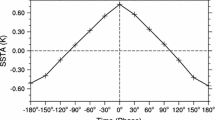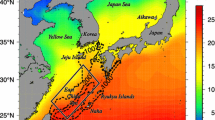Abstract
Relationships of the sea level differences between Naze and Nishinoomote and between Kushimoto and Uragami with wind stress over the North Pacific are examined for interannual variability. These sea level differences are considered to be indications of Kuroshio transport in Tokara Strait and Kuroshio path south of Enshu-nada, respectively.
In the sea level difference between Kushimoto and Uragami, dominant variations are found to have periods of about seven years and 3–4 years. The variation of about 7-year period, which corresponds to that in the Kuroshio path between the large meander and non-large meander, is coherent with the variation of the wind stress curl in a region about 2,400 km east of the Kii Peninsula, where negative stress curl weakens about two years before the sea level difference drops (i.e. the large meander path in the Kuroshio generates). The variation of the 3–4 year period is coherent with that of the wind stress in a large area covering the eastern equatorial Pacific, which suggests that it links with global-scale atmospheric variations.
Interannual variation in sea level difference between Naze and Nishinoomote is not coherent with that between Kushimoto and Uragami, which suggests that it is not related to the variation of the Kuroshio path south of Enshu-nada, but is coherent with that of the zonally-integrated Sverdrup transport in the latitudinal zone along 30°N. It is suggested that the interannual variation of the Kuroshio transport in Tokara Strait can be explained by the barotropic response to the wind stress.
Similar content being viewed by others
References
Chao, S.Y. (1984): Bimodality of the Kuroshio. J. Phys. Oceanogr.,14, 92–103.
Hellerman, S. and M. Rosenstein (1983): Normal wind stress over the world ocean with error estimates. J. Phys. Oceanogr.,13, 1093–1104.
Kawabe, M. (1980a): Sea level variations along the south coast of Japan and the large meander in the Kuroshio. J. Oceanogr. Soc. Japan,36, 97–104.
Kawabe, M. (1980b): Sea level variations around the Nansei Islands and the large meander in the Kuroshio south of central Japan. J. Oceanogr. Soc. Japan.36, 227–235.
Kawabe, M. (1985a): Sea level variations at the Izu Islands and typical stable paths of the Kuroshio. J. Oceanogr. Soc. Japan,41, 307–326.
Kawabe, M. (1985b): El Niño effects in the Kuroshio and western North Pacific. pp. 31–43.In: El Niño North-Niño Effects in the Eastern Subarctic Pacific Ocean, ed. by W.S. Wooster and D.L. Fluharty, Washington Sea Grant.
Kawabe, M. (1988): Variability of Kuroshio velocity assessed from the sea-level difference between Naze and Nishinoomote. Submitted to J. Oceanogr. Soc. Japan.
Kutsuwada, K. (1982): New computation of the wind stress over the North Pacific Ocean. J. Oceanogr. Soc. Japan,38, 159–171.
Kutsuwada, K. (1988): Spatial characteristics of interannual variability of wind stress over the western North Pacific. J. Climate,1, 333–347.
Kutsuwada, K. and T. Teramoto (1987): Monthly maps of surface wind stress fields over the North Pacific during 1961–1984. Bull. of Ocean Research Institute, University of Tokyo,24, 100pp.
Legler, D.M. and J.J. O'Brien (1984): Atlas of Tropical Pacific wind-stress climatology 1971–1980, Mesoscale Air-sea Interaction Group, Department of Meteorology, Florida State University, 182 pp.
Masuda, A. (1982): An interpretation of the bimodal character of the stable Kuroshio path. Deep-Sea Res.,29, 471–484.
Matsukawa, Y. (1979): A consideration on the mechanism of generation, stagnation and disappearance of the Kuroshio meander. J. Oceanogr. Soc. Japan,35, 118–125 (in Japanese with English abstract).
Moriyasu, S. (1958): On the fluctuation of the Kuroshio south of Honshû (4)—(The influence of the oceanographic conditions upon the monthly mean sea level). J. Oceanogr. Soc. Japan,14, 137–144.
Moriyasu, S. (1961): On the difference in the monthly sea level between Kushimoto and Uragami, Japan. J. Oceanogr. Soc. Japan,17, 197–200.
O'Brien, J.J. and S.B. Goldenberg (1981): Atlas of Tropical Pacific wind-stress climatology 1961–1970, Mesoscale Air-sea Interaction Group, Department of Meteorology, Florida State University, 182 pp.
Okada, M. and K. Nisnimoto (1978): Mean sea level along the south coast of Japan and large meanders of the Kuroshio from 1894 through 1924. Umi to Sora,54, 91–97 (in Japanese with English abstract and legends).
Rasmusson, E.M. and T.H. Carpenter (1982): Variations in tropical sea surface temperature and surface wind fields associated with the Southern Oscillation/El Niño. Mon. Wea. Rev.,110, 354–384.
Saiki, M. (1982): Relation between the geostrophic flux of the Kuroshio in the Eastern China Sea and its large-meanders in south of Japan. Oceanogr. Mag.,32, 11–18.
Taft, B. (1972): Characteristics of the flow of the Kuroshio south of Japan. pp. 165–216.In: Kuroshio-Its Physical Aspects, ed. by H. Stommel and K. Yoshida, Univ. Tokyo Press, Tokyo, 517 pp.
Tsumura, K. (1963): Investigation of the mean sea level and its variation along the coast of Japan (Part I)—Regional distribution of sea level variation. J. Geodetic Soc. Japan,9, 49–90 (in Japanese with English abstract and legends).
White, W.B. and J.P. McCreary (1976): On the formation of the Kuroshio meander and its relationship to the large-scale ocean circulation. Deep-Sea Res.,23, 33–47.
Wyrtki, K. (1975): El Niño-The dynamic response of the equatorial Pacific Ocean to atmospheric forcing. J. Phys. Oceanogr.,5, 572–584.
Yasuda, I., J.-H. Yoon and N. Suginohara (1985): Dynamics of the Kuroshio large meander.—Barotropic model—J. Oceanogr. Soc. Japan,41, 259–273.
Yoon, J.-H. and I. Yasuda (1987): Dynamics of the Kuroshio large meander: Two layer model. J. Phys. Oceanogr.,17, 66–81.
Author information
Authors and Affiliations
Rights and permissions
About this article
Cite this article
Kutsuwada, K. Interannual correlations between sea level difference at the south coast of Japan and wind stress over the north pacific. Journal of the Oceanographical Society of Japan 44, 68–80 (1988). https://doi.org/10.1007/BF02303122
Received:
Revised:
Accepted:
Issue Date:
DOI: https://doi.org/10.1007/BF02303122




